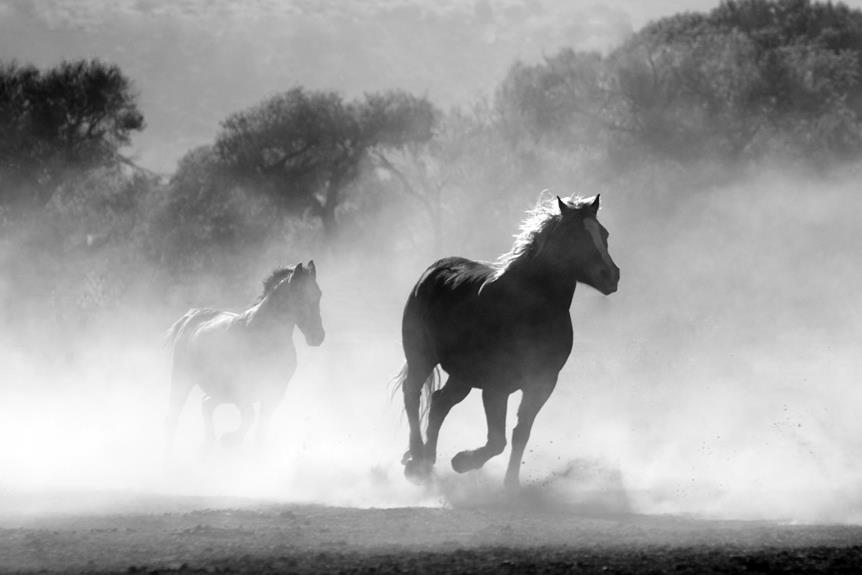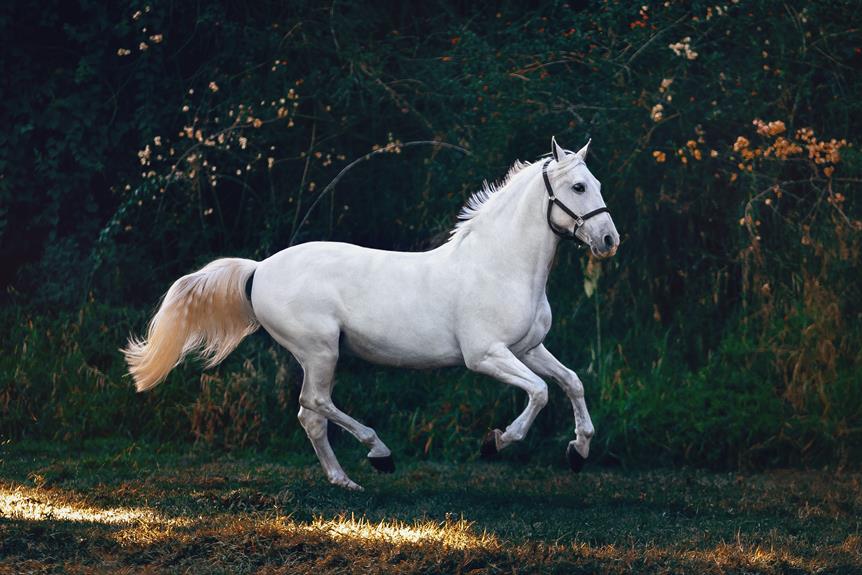Imagine you're standing at the edge of a vast field, observing a majestic horse. Its behavior can speak volumes, telling you whether it respects your authority or not.
How can you tell if a horse is disrespectful? Well, let's explore some signs that may leave you questioning its manners and seeking solutions.
From invading your personal space to ignoring your commands, these behaviors are like red flags waving in the wind, urging you to dig deeper into the world of horsemanship.
Key Takeaways
- Grazing while being led or ridden indicates a lack of respect and focus towards the handler or rider.
- Bumping into you or invading your personal space can be a sign of disrespect.
- Dragging or walking too slow when being led can be a sign of resistance and disrespect towards the handler's authority.
- Aggressive behavior during feeding time is a clear indication of a disrespectful horse.
Grazing While Being Led or Ridden
Grazing while being led or ridden indicates a lack of respect and focus towards the handler or rider. It's a clear sign of a disrespectful horse that isn't considering the authority of the person leading or riding it. This behavior shows that the horse is acting on its own desires and not paying attention to the commands or cues given by the handler.
To correct this disrespectful behavior, it's important to make the horse work every time it attempts to graze. This reinforces the handler's leadership and teaches the horse that grazing is only allowed when given permission. Groundwork techniques can also be used to address this issue. By establishing boundaries and communicating personal space, the horse will learn to respect the handler's authority and not engage in grazing while being led or ridden.
In addition to grazing, other signs of disrespect while being led include dragging or walking slowly. These behaviors should also be addressed to ensure a well-mannered horse. Using a rope halter and lunge whip, the handler can practice leading the horse and teach it to respond to pressure. This will encourage the horse to walk with purpose and stay focused on the handler's commands.
Bumping Into You
Sometimes, horses may unintentionally bump into you or step into your personal space, which can be a sign of disrespect. When a horse exhibits this behavior, it is important to address it promptly to ensure your safety and establish boundaries. By understanding the signs and implementing proper training techniques, you can correct this disrespectful behavior.
Here are some signs that your horse may be bumping into you or invading your personal space:
| Signs |
|---|
| – Horse frequently bumps into you |
| – Horse steps into your personal space |
| – Horse disregards your presence |
To address this behavior, you can start by working on leading exercises with your horse. Use a rope halter and a lunge whip to practice leading and respond to pressure. Make sure to maintain a consistent distance between you and the horse's head, and correct any attempts to invade your personal space. This will help your horse understand the boundaries and respect your personal space.
Additionally, incorporating groundwork techniques can be beneficial in establishing boundaries and communicating your expectations regarding personal space. Spend time teaching your horse to move away from pressure and respect your personal bubble.
Dragging or Walking Too Slow When Being Led
When horses exhibit the behavior of dragging or walking too slow when being led, it can be a sign of resistance and disrespect towards the handler's authority. This disrespectful horse may consistently refuse to move at the desired pace, showing a lack of cooperation and obedience. Here are some signs to look out for when dealing with a horse that drags or walks too slow when being led:
- The horse consistently pulls on the lead rope, making it difficult for the handler to control their movement.
- They may ignore or be unresponsive to cues and commands given by the handler during leading exercises.
- The horse may display a lack of respect for boundaries, pushing into the handler's personal space without regard for their presence.
This behavior can be an indication of a lack of training or a failure to establish clear leadership and boundaries with the horse. To address this issue, it's important to use a rope halter and employ consistent pressure and release techniques. By applying pressure when the horse drags or walks too slow and releasing the pressure when they respond appropriately, the horse can learn to respect the handler's authority and maintain the desired pace when being led.
Getting Aggressive During Feeding Time
During feeding time, horses may exhibit aggressive behavior, such as charging or knocking the handler, especially when food is present. These signs of aggression are a clear indication of a disrespectful horse. When a horse becomes aggressive during feeding time, it's important to address the issue promptly to ensure the safety of both the horse and the handler.
One of the signs of an aggressive horse during feeding time is when its ears are pinned back. This indicates that the horse is irritated or angry. Additionally, if the horse lifts its front hoof in a striking movement towards the bars or the handler, it's displaying aggressive behavior.
Aggression during feeding time can be caused by various factors. It's possible that the horse is in pain or discomfort, which leads to frustration and aggression. Another reason could be an empty bucket or not enough food, causing the horse to become anxious and aggressive.
To prevent aggression during feeding time, it's important to create a calm and level area where the horse can eat undisturbed. It's also crucial to ensure that each horse has its own designated feeding space to avoid competition and potential aggression.
Acting Out While Riding
After addressing aggression during feeding time, it's important to address the issue of horses acting out while riding. When a horse acts out while you're on its back, it can be frustrating and even dangerous. Here are some signs that your horse may be displaying disrespectful behaviors while riding:
- Pushing and invading personal space: Your horse may constantly push against you or crowd you while riding, making it difficult to maintain your own balance and control.
- Disobedience under saddle: If your horse is rearing, bucking, or resisting your cues, it's a clear sign of disrespect and a refusal to cooperate with you as the rider.
- Ignoring cues or commands: When your horse consistently fails to respond to your instructions, it shows a lack of respect for your authority as a horseback rider.
- Dragging on the lead rope: If your horse refuses to walk at your pace or simply refuses to move at all, it's a sign of disrespect and a refusal to follow your lead.
- Fall behind or stop frequently: A disrespectful horse may constantly fall behind or stop during the ride, refusing to keep up with your pace.
To address these disrespectful behaviors, it's important to focus on ground work exercises and training. By establishing clear boundaries and expectations on the ground, you can teach your horse to respect you as the leader.
Additionally, consistent and patient training can help your horse learn to push past its disrespectful behaviors and become a more obedient and cooperative riding partner.
Frequently Asked Questions
How Do You Know if Your Horse Doesn't Like You?
If your horse doesn't like you, they may show it through their body language cues, lack of cooperation, avoidance behavior, unwillingness to be caught, ignoring cues and commands, aggressive behavior, excessive spookiness, refusing to stand still or be handled, unpredictable reactions, and a lack of bonding or connection.
How Do You Fix a Disrespectful Horse?
To fix a disrespectful horse, establish boundaries, build trust, and provide consistency in training. Address fear and anxiety, reinforce positive behavior, and seek professional help if needed. Identify underlying health issues and adjust the horse's environment. Use positive reinforcement techniques and understand the horse's body language.
How Do You Know if a Horse Isn't Right for You?
If a horse isn't right for you, there are several signs to look for. These include behavioral cues like lack of trust, inconsistent performance, ignoring cues, aggressive behavior, lack of bonding, resistance to handling, disengagement in training, disinterest in rider's cues, and lack of enthusiasm in work.
How Do Horses Show Respect?
To show respect, horses understand your body language, trust is built through consistent training, and boundaries are established. Recognize signs of disrespect and correct them with communication techniques, building a strong partnership and patience.
Conclusion
In conclusion, recognizing and addressing signs of disrespect in a horse is crucial for maintaining a safe and harmonious relationship.
By addressing behaviors such as invading personal space, pushing, nipping, and ignoring commands, we can establish clear boundaries and assert our authority as leaders.
Through consistent training and clear communication, we can help our horses understand and respect these boundaries, creating a more respectful and enjoyable partnership.



0 Comments